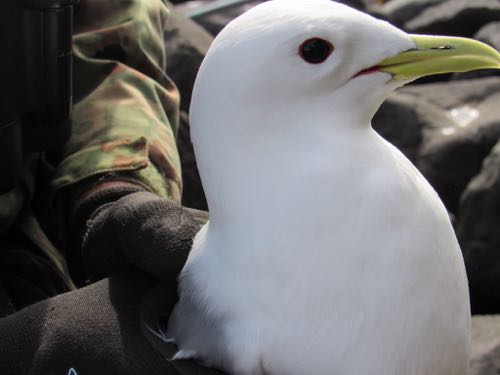Birdcatching... and hair dye?
The biggest office rule here is to move S L O W L Y. Seabirds, being the wild animals they are, are unaccustomed to humans, skittish and fly away easily. Of course, this doesn't help when you're trying to capture them, so patience is key.
Seabirds love nesting on cliffsides, or among the rocks at the top of the cliffs, so when trying to capture them, you can work from below and reach up, or you can rappel down and reach them from above. Think stealth mode a la hunting, but without a weapon, and choosing a particular bird out of many.
 Observe the birds closely. These kittiwakes are close together, and it can be tricky to know which bird is the correct one.
Observe the birds closely. These kittiwakes are close together, and it can be tricky to know which bird is the correct one.
Which bird?
There is a map of identified nests from the two previous seasons, and the team is constantly updating it. It's like a game of where's Waldo, just with birds, nests, and cliff crevices! So if you were wondering, no random birds are chosen. It's very methodical. Match the bird to the nest(s) on the map, observe the birds to see if they're banded (not always possible to see), if they're incubating an egg, if there's a partner, etc. In other words, once you find the right nest, you want to do everything possible to ensure the right bird is in it.
 Comparing the focus nests with those on the map is critical until you know them by heart.
Comparing the focus nests with those on the map is critical until you know them by heart.
Capturing birds from below
The noose pole is one tool for capturing birds, with a noose made of a very thick type of fishing line. It's thick enough not to hurt the birds, and it's more stable in windy conditions than regular fishing line would be. The noose is at the end of telescoping rods, similar to carbon fiber fishing rods, which can reach 25-40', depending on whether we use the short or the long pole.
Ready the noose and find the best angle of approach both for remaining unseen by the bird and to have solid footing to hold the pole.
Telescope the noose on the pole ever so slowly (remember the big office rule?) up to the bird.
Turn the noose so it is around the bird, then pull gently but firmly so it's snug, pull the pole down and away to your teammate who then retrieves the bird for measurements.
 The noose pole and our field supplies for post-capture.
The noose pole and our field supplies for post-capture.
 My teammate, researcher and NatGeo Explorer, JB Thibot, goes after his next capture.
My teammate, researcher and NatGeo Explorer, JB Thibot, goes after his next capture.
Insert happy joy joy celebration emoji here! I caught my first bird today with the long pole!
 Me, on the prowl, and within seconds of my first capture! Photo by JB Thibot.
Me, on the prowl, and within seconds of my first capture! Photo by JB Thibot.
Even though seabirds have high fidelity to their nests of previous years, some nests remain empty, or have different birds. Ideally, GLS birds – those with the loggers on them, will return to their original nests so we can recapture the trackers, and hence, the data. If the birds captured aren't the birds we'd hoped for, we can still get measurements and samples for analysis.
 Once a bird is captured, summon your inner bird whisperer to calm it, hold it firmly and quietly so as not to further stress them.
Once a bird is captured, summon your inner bird whisperer to calm it, hold it firmly and quietly so as not to further stress them.
 Curious little fellas like these crested and least auklets are always watching us.
Curious little fellas like these crested and least auklets are always watching us.
 The pigeon guillemots love to play in the air and dive in the water, but love to take breaks to be our audience, too. They have distinctive bright red feet and legs, which apparently help regulate their body temperature!
The pigeon guillemots love to play in the air and dive in the water, but love to take breaks to be our audience, too. They have distinctive bright red feet and legs, which apparently help regulate their body temperature!
As for hair dye? ...Yeah, that's to be continued...
Today's Tweet:
Observing birds takes patience, but there's always an entertaining show watching murre rafts, kittiwake conversations, and constant flights of birds overhead. #yearofthebird


Comments
Add new comment